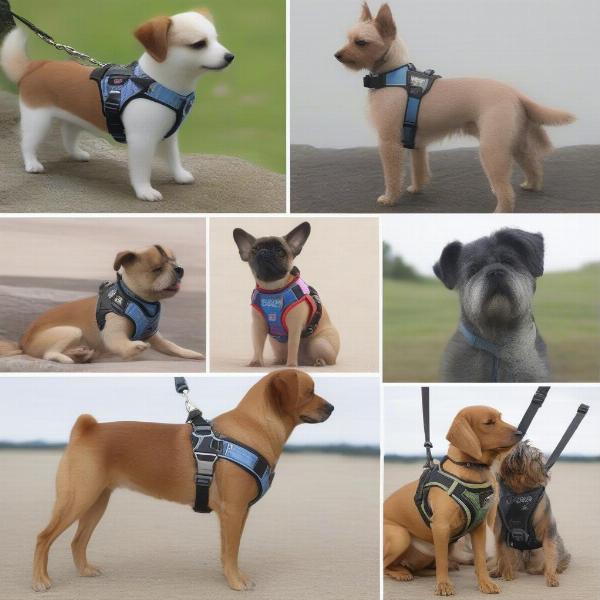Choosing the right harness for your little dog can significantly impact their comfort, safety, and overall well-being. Whether you’re embarking on daily walks, adventurous hikes, or simply need a secure way to manage your pup, a well-fitted harness is essential. This comprehensive guide explores the world of harnesses designed specifically for small breeds, helping you navigate the various types, sizes, and features to find the perfect fit for your furry friend.
Choosing the Right Harness for Your Small Dog
With so many harnesses available, selecting the best one can feel overwhelming. Consider your dog’s breed, size, and activity level. A Chihuahua will have different needs than a Miniature Poodle. For tiny dogs, a lightweight, adjustable harness is crucial, while more energetic small breeds may benefit from a harness with added features like a handle for better control.
 Different Types of Harnesses for Small Dogs
Different Types of Harnesses for Small Dogs
Types of Harnesses for Small Dogs
Several types of harnesses cater specifically to the needs of smaller dogs. Each design offers unique advantages and disadvantages.
Back-Clip Harnesses:
These harnesses feature a D-ring on the back for leash attachment. They’re simple to use and generally comfortable for relaxed walks, ideal for well-behaved small dogs who don’t pull.
Front-Clip Harnesses:
Front-clip harnesses have the leash attachment point on the chest. This design discourages pulling by gently redirecting the dog’s forward momentum. It’s a great option for small dogs prone to pulling or those in training.
Vest Harnesses:
Vest harnesses offer more coverage and support, often preferred for small breeds with delicate tracheas. The wider straps distribute pressure evenly, reducing strain on the neck and chest. These are particularly beneficial for brachycephalic breeds like Pugs or French Bulldogs.
Step-In Harnesses:
As the name suggests, step-in harnesses require the dog to step into the leg holes and fasten over the back. While easy to put on for some dogs, others may find them less comfortable. Ensuring a proper fit is paramount to prevent chafing.
Finding the Perfect Fit: Measuring Your Small Dog
A properly fitted harness is vital for both comfort and safety. Use a soft tape measure to determine your dog’s girth around the chest, just behind the front legs. Refer to the manufacturer’s size chart for each specific harness, as sizing can vary between brands.
Harness Training for Small Dogs
Introducing a harness to your small dog should be a positive experience. Start by letting them sniff and investigate the harness, then gradually introduce it for short periods, rewarding them with treats and praise. Once they are comfortable wearing the harness, attach the leash and begin with short, supervised walks.
Maintaining Your Dog’s Harness
Regularly check your dog’s harness for wear and tear. Clean it according to the manufacturer’s instructions, as this will vary depending on the material. A well-maintained harness will last longer and ensure your dog’s continued comfort and safety.
Conclusion
Choosing the right harness for your little dog involves considering their individual needs and preferences. By understanding the different types of harnesses available and ensuring a proper fit, you can provide your furry companion with a comfortable and secure walking experience. A good harness not only enhances safety and control but also promotes a stronger bond between you and your beloved pet.
FAQ
- How do I know if my small dog’s harness fits correctly? You should be able to fit two fingers comfortably between the harness and your dog’s body.
- What is the best type of harness for a small dog that pulls? A front-clip harness is generally recommended for small dogs who tend to pull.
- Can I use a harness for training my small dog? Yes, harnesses can be used for training, particularly those with front-clip attachments.
- How often should I clean my dog’s harness? Clean the harness regularly, especially after muddy or wet walks. The frequency will depend on the material and how often it’s used.
- Are harnesses better than collars for small dogs? Harnesses are often preferred for small dogs as they distribute pressure more evenly and reduce strain on the neck.
- What should I look for in a harness for a brachycephalic breed? Choose a vest-style harness that provides good support and avoids pressure on the trachea.
- Can I leave a harness on my small dog all the time? It is generally not recommended to leave a harness on a dog all the time as it can cause skin irritation or matting.
ILM Dog is a leading online resource dedicated to providing dog owners with expert advice and information on all aspects of dog care, from breed selection and health to training, nutrition, and grooming. We offer a wide selection of high-quality dog products and accessories to help enhance your dog’s well-being. Whether you’re a seasoned dog owner or just starting your journey, ILM Dog is here to support you every step of the way. For expert advice or to explore our product range, contact us at [email protected] or call +44 20-3965-8624. Visit us at ILM Dog for more valuable information and resources.